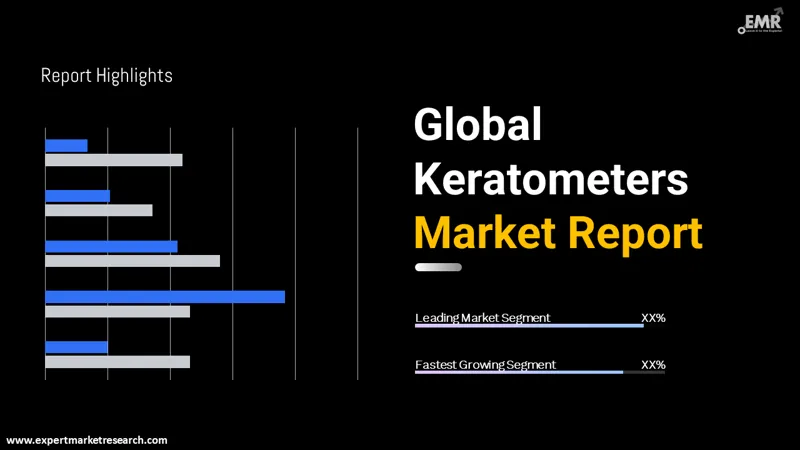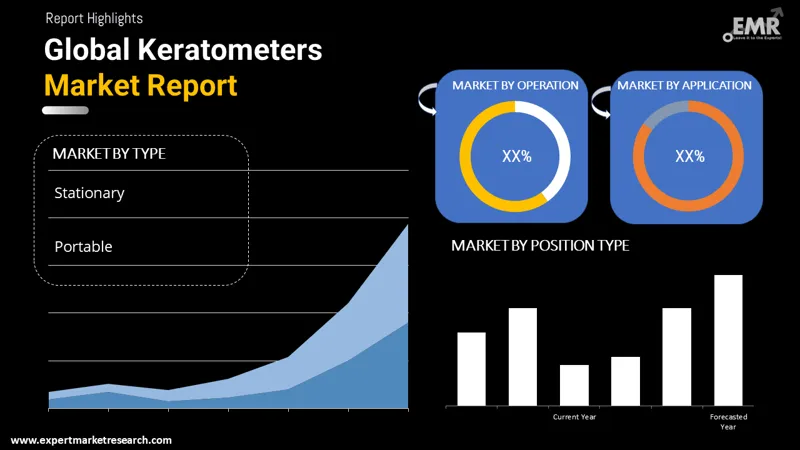
Consumer Insights
Uncover trends and behaviors shaping consumer choices today
Procurement Insights
Optimize your sourcing strategy with key market data
Industry Stats
Stay ahead with the latest trends and market analysis.
Base Year
Historical Year
Forecast Year






The global keratometers market was valued at USD 274.39 million in 2024, driven by the increasing prevalence of eye disorders like astigmatism, keratoconus among others and technological advancements in keratometers across the globe. The market is expected to grow at a CAGR of 6.12% during the forecast period of 2025-2034, with the values likely to reach USD 433.92 million by 2034.

Read more about this report - REQUEST FREE SAMPLE COPY IN PDF
Keratometers refer to specialized instruments or platforms designed for the detection and identification of infectious agents, such as viruses, bacteria, fungi, and parasites, through molecular methods. These devices employ various molecular diagnostic technologies to amplify and analyze nucleic acids (e.g., DNA or RNA) specific to pathogens present in clinical samples obtained from patients.
The keratometers market size has been expanding steadily. The factors such as rising healthcare expenditure, increasing awareness about eye health, and advancements in ophthalmic technology contribute to market expansion. Moreover, the growing demand for vision correction procedures like LASIK surgery or implantable contact lenses, which require precise pre-operative assessments using keratometry augmenting the market growth.
Technological advancements play a pivotal role in shaping the market. Integration of advanced imaging techniques like optical coherence tomography (OCT) or topography enhances the accuracy and efficiency of corneal measurements, driving adoption among clinicians and patients.
Increasing Prevalence of Eye Disorders
The rising incidence of eye disorders such as myopia, astigmatism, and keratoconus is a significant driver of the market growth. These conditions require precise diagnostic tools for assessment and monitoring. As the prevalence of these disorders continues to increase globally, the demand for keratometers rises proportionally.
For instance, According to the American Academy of Ophthalmology, in United States, refractive error occurs in about 1 in 3 people and may occur in combination with near- or farsightedness. It causes blurry vision and is due to the cornea being less than perfectly rounded.
Astigmatism is a common refractive error characterized by an irregular curvature of the cornea or lens, resulting in blurred or distorted vision. Keratometers are essential diagnostic tools for assessing astigmatism by measuring the curvature of the cornea and hence leads to increase in market growth.
Rising Incidence of Refractive Surgeries and Technological Innovations Expected to Propel Keratometers Market Demand
Refractive surgeries like LASIK (Laser-Assisted in Situ Keratomileusis) and PRK (Photorefractive Keratectomy) are popular procedures for correcting vision problems. Pre-operative assessment of corneal curvature and shape is crucial for determining the suitability of patients for these surgeries and predicting outcomes. It provides essential measurements of corneal curvature and shape, helping surgeons determine the appropriate surgical approach and predict outcomes accurately. As the demand for refractive surgeries continues to rise, the need for accurate and reliable pre-operative evaluations with keratometers increases correspondingly.
Moreover, the continuous technological innovations in keratometry contribute to improved accuracy, efficiency, and ease of use. Advanced keratometers integrate features such as artificial intelligence algorithms, enhancing diagnostic capabilities and streamlining workflow in refractive surgery clinics. These innovations not only improve the precision of measurements but also facilitate faster and more reliable data interpretation, ultimately optimizing surgical planning and patient outcomes. This expanded accessibility allows refractive surgery clinics to invest in keratometry equipment more readily, regardless of their size or resources. Portable keratometers enable outreach programs, mobile clinics, and remote healthcare facilities to perform pre-surgical assessments efficiently, thereby increasing access to refractive surgeries and thus driving the market demand.

Read more about this report - REQUEST FREE SAMPLE COPY IN PDF
The market is witnessing several trends and developments to improve the current global scenario. Some of the notable trends are as follows:
| Key Trends | Impact |
| Technological Advancements | Manufacturers are incorporating features such as automated measurements, integration with other diagnostic tools, and advanced imaging techniques. For instance, modern keratometers use laser technology or high-resolution imaging sensors for better corneal surface details. |
| Integration of Artificial Intelligence (AI) | AI-driven algorithms are being integrated into keratometers to automate measurements, analyze corneal data, and assist clinicians in diagnosis and treatment planning. |
| Wireless Connectivity | Wireless connectivity options allow keratometers to communicate with other devices such as computers, tablets, or smartphones. This enables real-time data transfer, remote monitoring, and telemedicine applications, facilitating collaboration among healthcare professionals and improving patient care accessibility. For instance, Coburn Technologies, Inc., provides one-of-a-kind HRK-9000A offers a Meibomian Gland Analysis function and Tear Film Break Up Time (TFBUT) measurement. The product features include wireless communication, full compatibility with all EMR Systems. |
| Integration with Electronic Health Records (her) | Keratometers now offer seamless integration wiherEHR systems, streamlining data management and improving workflow efficiency in ophthalmic practices. This integration enables quick access to patient records and facilitates communication between healthcare providers. |
Market Breakup by Type
Market Breakup by Position Type
Market Breakup by Operation
Market Breakup by End User
Market Breakup by Region
Market Segmentation Based on Type is Anticipated to Witness Substantial Growth
By type, the market is segmented into stationary and portable. The stationary segment is expected to hold a substantial share as in big clinical settings with high patient throughput. Stationary keratometers are preferred for their comprehensive capabilities and efficiency in handling large volumes of examinations. The portable keratometers are holding good market share as it offers flexibility and accessibility, making them suitable for environments where mobility and outreach are prioritized, or resources are limited.
Based on the region, the market covers North America, Europe, Asia Pacific, Latin America, and the Middle East and Africa. North America is dominating the market share with its well-developed healthcare infrastructure with state-of-the-art facilities, advanced diagnostic equipment, and highly skilled healthcare professionals.
Europe also holds a significant keratometers market value as the region is witnessing a rise in the prevalence of eye disorders such as myopia, astigmatism, and keratoconus. These conditions necessitate precise diagnostic tools like keratometers for accurate assessment and management and thus driving the market growth.
Additionally, Asia Pacific is expected to witness substantial market growth due to increasing cases of eye disorders and rapidly growing healthcare infrastructure.
The key features of the market report include strategic initiatives such as recent partnerships and collaborations by the leading players. The major companies in the market are as follows:
Carl Zeiss AG
Carl Zeiss AG, a renowned German company specializing in optics and optoelectronics, is a prominent player in the field of ophthalmic devices, including keratometers, designed to measure the curvature of the cornea accurately.
Canon, Inc.
The company, established in 1937 is headquartered in Tokyo, Japan. It is a Japanese MNC that is known for production of optical and industrial products including scanners, lenses, printers, cameras, and medical equipment including keratometers.
Nidek Co., Ltd.
Nidek Co., Ltd., a Japanese company specializing in the manufacturing of ophthalmic equipment and devices, is a significant player in the field of keratometers.
Other key players in the market include Micro Medical Devices (MMD), Inc., Reichert, Inc., Coburn Technologies, Inc., HAAG-STREIT GROUP, and Topcon Corporation among others.
| REPORT FEATURES | DETAILS |
| Base Year | 2023 |
| Historical Period | 2018-2024 |
| Forecast Period | 2025-2034 |
| Scope of the Report |
Historical and Forecast Trends, Industry Drivers and Constraints, Historical and Forecast Market Analysis by Segment:
|
| Breakup by Type |
|
| Breakup by Position Type |
|
| Breakup by Operation |
|
| Breakup by End User |
|
| Breakup by Region |
|
| Market Dynamics |
|
| Supplier Landscape |
|
| Companies Covered |
|
*While we strive to always give you current and accurate information, the numbers depicted on the website are indicative and may differ from the actual numbers in the main report. At Expert Market Research, we aim to bring you the latest insights and trends in the market. Using our analyses and forecasts, stakeholders can understand the market dynamics, navigate challenges, and capitalize on opportunities to make data-driven strategic decisions.*
Get in touch with us for a customized solution tailored to your unique requirements and save upto 35%!
Datasheet
One User
USD 3,299
USD 2,969
tax inclusive*
Single User License
One User
USD 5,499
USD 4,949
tax inclusive*
Five User License
Five User
USD 6,999
USD 5,949
tax inclusive*
Corporate License
Unlimited Users
USD 8,199
USD 6,969
tax inclusive*
*Please note that the prices mentioned below are starting prices for each bundle type. Kindly contact our team for further details.*
Flash Bundle
Small Business Bundle
Growth Bundle
Enterprise Bundle
*Please note that the prices mentioned below are starting prices for each bundle type. Kindly contact our team for further details.*
Flash Bundle
Number of Reports: 3
20%
tax inclusive*
Small Business Bundle
Number of Reports: 5
25%
tax inclusive*
Growth Bundle
Number of Reports: 8
30%
tax inclusive*
Enterprise Bundle
Number of Reports: 10
35%
tax inclusive*
How To Order
Our step-by-step guide will help you select, purchase, and access your reports swiftly, ensuring you get the information that drives your decisions, right when you need it.

Select License Type
Choose the right license for your needs and access rights.

Click on ‘Buy Now’
Add the report to your cart with one click and proceed to register.

Select Mode of Payment
Choose a payment option for a secure checkout. You will be redirected accordingly.
Gain insights to stay ahead and seize opportunities.

Get insights & trends for a competitive edge.

Track prices with detailed trend reports.

Analyse trade data for supply chain insights.

Leverage cost reports for smart savings

Enhance supply chain with partnerships.

Connect For More Information
Our expert team of analysts will offer full support and resolve any queries regarding the report, before and after the purchase.
Our expert team of analysts will offer full support and resolve any queries regarding the report, before and after the purchase.
We employ meticulous research methods, blending advanced analytics and expert insights to deliver accurate, actionable industry intelligence, staying ahead of competitors.
Our skilled analysts offer unparalleled competitive advantage with detailed insights on current and emerging markets, ensuring your strategic edge.
We offer an in-depth yet simplified presentation of industry insights and analysis to meet your specific requirements effectively.



Australia
63 Fiona Drive, Tamworth, NSW
+61-448-061-727
India
C130 Sector 2 Noida, Uttar Pradesh 201301
+91-723-689-1189
Philippines
40th Floor, PBCom Tower, 6795 Ayala Avenue Cor V.A Rufino St. Makati City,1226.
+63-287-899-028, +63-967-048-3306
United Kingdom
6 Gardner Place, Becketts Close, Feltham TW14 0BX, Greater London
+44-753-713-2163
United States
30 North Gould Street, Sheridan, WY 82801
+1-415-325-5166
Vietnam
193/26/4 St.no.6, Ward Binh Hung Hoa, Binh Tan District, Ho Chi Minh City
+84-865-399-124
United States (Head Office)
30 North Gould Street, Sheridan, WY 82801
+1-415-325-5166
Australia
63 Fiona Drive, Tamworth, NSW
+61-448-061-727
India
C130 Sector 2 Noida, Uttar Pradesh 201301
+91-723-689-1189
Philippines
40th Floor, PBCom Tower, 6795 Ayala Avenue Cor V.A Rufino St. Makati City, 1226.
+63-287-899-028, +63-967-048-3306
United Kingdom
6 Gardner Place, Becketts Close, Feltham TW14 0BX, Greater London
+44-753-713-2163
Vietnam
193/26/4 St.no.6, Ward Binh Hung Hoa, Binh Tan District, Ho Chi Minh City
+84-865-399-124
Share